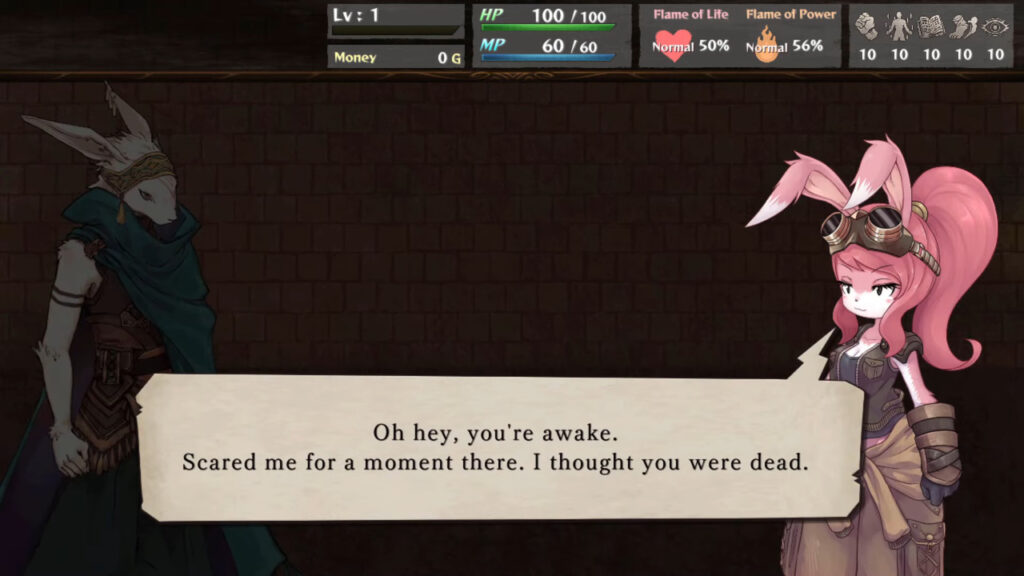
The Use of Life – Preview
With The Use of Life, Daraneko Games is making its debut as an indie developer. The game, which is currently in Early Access on Steam, already looks to be an interesting title purely based on its concept, which marries classic JRPG gameplay with an innovative combat system and a choice-driven narrative. This is made all the more impressive by the fact that it was made by a single dev too. We took a look at what The Use of Life has to offer ahead of its mainstream release. Do the foundations show potential or isn’t there enough here to warrant jumping in early?
The story of The Use of Life revolves around Goshe, an anthropomorphic rabbit hailing from the village of Rabinia. Goshe is set to become the next chieftain of Rabinia, but his world is turned upside down when a dragon attacks the village, killing every inhabitant and razing the settlement to the ground. As the sole survivor, Goshe finds himself waking up locked up in a bandit hideout at the start of the game. Naturally, our hero finds a way to escape, alongside his new companion Misha, a sarcastic pink rabbit girl. The pair set out to exact revenge on the dragon that destroyed Rabinia. What follows is a story that is shaped by the choices made during gameplay, and as such it will differ from player to player.
At the time of writing, The Use of Life is still in Early Access, which means that things look unfinished and unpolished, but even so there are already some clues as to what the final result will look like. Right now, the art direction is fantastic but the overall visual execution is missing visual punch, mainly because of how inconsistent things are. In combat, enemies are represented through static sprites, for example, whereas Goshe himself is animated, albeit in a limited way. Likewise, the animated Goshe has thick black outlines not present in the other character designs. Finally, there are distinct stylistic differences between the various characters present in the game. Misha looks much more like a bubbly anime character compared to the stoic Goshe, and the different enemies adopt even more outlandish art styles. Hopefully, the final version of the game will add more consistency to the character designs.
One thing we’re hoping for is that the currently present music is here as a placeholder rather than as the definitive music. For the most part, the game’s soundtrack consists of generic adventure music, which is fine enough but for some inexplicable reason, most tracks incorporate dubstep as well, which feels very much out of place in a fantasy game about a rabbit man that wants to find and kill a dragon. Sound effects are decent enough and there is no voice acting present.
From a conceptual point of view, The Use of Life certainly has a lot going for it. The main gameplay experience centers around classic JRPG gameplay with turn-based combat. However, unlike most JRPGs, the story doesn’t follow a set path, instead shaping itself around the choices the player makes. This approach deliberately feels like a choose-your-own-adventure book, and it really helps to make The Use of Life feel like a unique title rather than yet another JRPG. It goes deeper than simply making a story choice, as the cumulative impact of your choices changes and shapes Goshe’s character, unlocking different choice options later on in the game. This is done through the so-called “Flame of Life” and “Flame of Power” stats, which are represented through percentages at the top of the screen most of the time. They represent Goshe’s two main personality aspects and as such the way he interacts with the world. This adds a significant degree of replayability to the game as no two playthroughs will turn out exactly the same depending on the choices made.
Of course, there are certain limits that are the inevitable consequence of structuring a game like this. The more choices there can be made, the more branches the developer has to implement in order to make things feel coherent. This is countered by limiting the number of moments that choices can actually be made: the game’s overworld map is presented through a number of fixed locations that are visited in a specific order. There is no free-roaming in an open world present here, which is understandable given how much this would require the game to be upscaled. Still, we would’ve preferred a more fleshed-out world as things feel rather limited right now in this regard, especially when you’re aiming to grind out random combats for experience. Right now, the necessity for said grind isn’t all that present as there is only a limited amount of content available but we expect The Use of Life to turn into a pretty sizable JRPG down the line.
The majority of combat is resolved in a turn-based way, although successfully executing attacks often involves quick-time-event button presses, both for attacking and dodging. This means that you constantly have to pay attention to the fights, and it makes The Use of Life less suited as the type of game you’d play while actually doing something else as you really need to keep focus. There is a healthy degree of combat customizability present in the game, allowing you to shape the main character to fit your personal playstyle. For the most part, you rely on choosing one of the four initial specific character classes for Goshe, ranging from fighter and samurai to sorcerer and mage. Each class comes with its own set of special skills. As you progress, more advanced classes become available as well, such as the swordmage or the sage. These add a sense of character growth and aid in making the player connect with Goshe.
Further customization is available through items and gear, and stat growth. Of note is that stat growth affects more than just how Goshe performs in combat. Applying points to specific stats may open up new ways to make your way through the game, such as being able to talk your way out of an enemy encounter rather than having to deal with combat. Naturally, stat gains will still take effect should combat follow, and the game indicates what happens when you make specific changes to a stat. For example, you might be able to increase your dodge time by allocating points into your speed stat whereas a higher technical stat will increase your critical hit ratio.
At the time of writing, only the first two chapters of the game are available but they already give us a decent look at what the full game will end up like. It will be interesting to see just how much importance will be given to the Flame of Life and Flame of Power and how these influence the flow of the story when future chapters are released. For now, The Use of Life showcases a decent amount of potential in terms of gameplay, although it’s clear that it could use more fleshing out as well.
Conclusion
The combination of a JRPG with turn-based combat with a visual novel style choose-your-own-adventure works surprisingly well and has us eagerly looking forward to the definitive version of The Use of Life. The €17.99 price of entry feels a little steep at the moment but as more content is added and polished over time, that will become easier to swallow. It may not be an Early Access title to download immediately, but it is definitely one to keep your eye on. There’s a free demo available so you can give the game a spin before you decide whether or not to commit.
The Use of Life - Preview,









No Comments